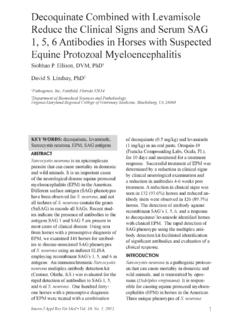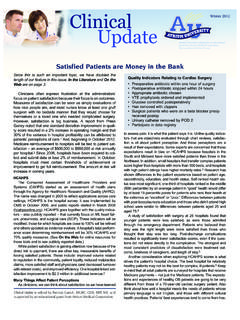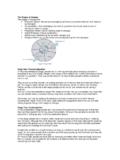Transcription of Left Ventricular Reverse Remodeling After Ductal …
1 Vol. 11, No. 1, 2013 Intern J Appl Res Vet WORDS: Dogs, Patent ductus arteriosus, Ventricular remodelingABSTRACTThe purpose of the present study was to evaluate whether or not preoperative clinical parameters could predict left Ventricular Reverse Remodeling in dogs who underwent successful patent ductus arteriosus (PDA) closure. Thirty-nine client-owned dogs diag-nosed as PDA with left Ventricular dilation were used. Increased left Ventricular internal dimension index and decreased fractional shortening acquired before the Ductal cor-rection were identified as the independent predictors of short-term regression of left Ventricular dilation. Therefore, left ventricu-lar dilation and decreased systolic function prior to Ductal closure may predict failure of early post-operative left Ventricular Reverse ductus arteriosus (PDA) with left-to-right shunting causes volume overload of the left side of the heart, resulting in eccentric hypertrophy of the left side of the heart.
2 The heart size and function were expected to return to a normal reference range After the successful closure of the PDA. However, it has been reported that the persistence of abnormal systolic indices as well as car-diomegaly After the closure are commonly This phenomenon could be due to changes in hemodynamics and/or impaired cardiac function subsequent to cardiac re-modeling. Persistent cardiomegaly and myo-cardial dysfunction cause clinical signs and even death in some dogs After Ductal closure. There is ample evidence available support-ing the PDA closure as a curative measure. However, it is unclear who is predisposed to fail After short-term Reverse cardiac remodel-Left Ventricular Reverse Remodeling After Ductal Closure in Dogs with Hemodynamically Significant Patent Ductus Arteriosus Ryokichi IshikawaYoko FujiiHiroshi TakanoHiroshi SunaharaTakuma AokiYoshito WakaoDepartment of Surgery 1, School of Veterinary Medicine, Azabu University, 1-17-71 Fuchinobe, Chuo-ku, Sagamihara-shi, Kanagawa, Japan, zip 252-5201 Correspondence; Yoko Fujii, DVM, , DipACVIM (Cardiology), Department of Surgery I, School of Veterinary Medicine, Azabu University, 1-17-71 Fuchinobe, Chuo-ku, Sagamihara-shi, Kanagawa, Japan, zip 252-5201, tel +81-42-754-7111, fax +81-42-850-2456, e-mail J Appl Res Vet Med Vol.
3 11, No. 1, , which implies that residual Ventricular dysfunction persists After the closure. The purpose of the present study was to evalu-ate whether preoperative clinical param-eters could predict left Ventricular Reverse Remodeling in dogs who undergo successful PDA AND MeThODSC lient-owned dogs diagnosed as left-to-right PDA at Azabu University Veterinary Teaching Hospital from 2006 to 2010 were reviewed. Dogs were included in the study if they showed cardiomegaly due to PDA, and were treated surgically or by catheter occlu-sion with successful closure. Dogs who had a significant residual shunt with an audible continuous murmur After an attempt of PDA closure were excluded from the at the time of Ductal closure, the LV internal dimension at the end-diastole (LVIDd), fractional shortening (FS%) using ultrasound equipment (Vivid 7 dimensions, GE Medical System, Tokyo, Japan) and body weight were recorded pre-operatively.
4 Echocardiographic examinations took place with the patient in right lateral recumbency. An electrocardiography was recorded si-multaneously with the echocardiogram. The transducer frequency was 10 or MHz, and either or both frequencies used for each dog to provide optimal 2D imaging. LVIDd were measured by M-mode echocardiog-raphy performed from the right parasternal short-axis view at the chordate tendineae level. LVIDd indexes were calculated using the same formula described in the previous Mean measurements from three cardiac cycles for each parameter were used for analysis. Follow-up echocardiography was obtained from medical records. Dogs were divided into two groups: One where cardiomegaly was improved and disappeared within 30 days post Ductal closure (N group) oOne where cardiomegaly was still observed at follow-up within 30 days After Ductal closure (D group), which was defined that the LVIDd index was not returned to within normal reference range 2 or deteriorated After the Ductal closure compared with pre-operative analyses were performed with the statistical package for Ekuseru-Toukei 2010.
5 Results were expressed as mean standard deviation. In order to examine the effect of LV Reverse Remodeling , multiple regression analysis was performed with pre-dictor variables: age, body weight, LVIDd index, and FS% at the time of PDA closure. A difference with P< was considered TSA total of 39 dogs were included in the study. Breeds represented were Pomera-nian (9), Miniature dachshund (8), Toy poodle (6), mixed breed (3), Chihuahua (2), Shetland sheepdog (2), Yorkshire terrier (1), Maltese (1), Spitz (1), Italian greyhound (1), Irish setter (1), Welsh corgie (1), Miniature N group (n=26)D group (n=13)BeforeAfterBeforeAfterAge at the time of Ductal closure (months) weight (kg) (%) 1. Clinical characteristics and echocardiographic findings before and After the Ductal closure in each 11, No. 1, 2013 Intern J Appl Res Vet (1), German shepherd (1), and Pa-pillon (1). Twenty-six dogs were females and 13 dogs were males.
6 Mean body weight was kg (ranging from to kg). Mean age at the time of Ductal closure was months (ranging from 1 to 90 months). Seventeen dogs underwent surgical ligation and 22 dogs were treated by trans-catheter occlusion. Median follow-up days post- Ductal closure was 11 days (ranging from 1 to 30 days). The LVIDd index was normalized in 26 dogs (N group). In contrast, 13 dogs did not show improvement in the LVIDd index (D group). Clinical characteristics and echo-cardiographic findings before and After the Ductal closure in each group were shown in Table 1. Multiple regression analysis identi-fied the LVIDd index (odds ratio , p = ) and FS% (odds ratio , p = ) as the independent predictors of short-term LV Reverse mechanical stretch of myocytes due to volume overload caused by PDA induces enhanced expression of angiotensin II, endothelin, myocardial TGF- , and others to induce eccentric hypertrophy.
7 As a result, the wall tension of ventricles decreased and normalized. However, hypertrophy is a complex signaling system, and its involve-ment also results in a variety of potentially adverse effects such as fibrosis and possibly apoptosis. A previous study reported that late post-operative cardiac-related death was noticed in some dogs with The reason for cardiac death despite successful PDA closure could be due to myocardial dysfunc-tion detected prior to surgery caused by volume overload. This indicates that some dogs with irreversible structural changes caused by long-standing severe volume overload may not show Reverse Remodeling irrespective of volume unloading of LV After surgery. It was reported that PDA ligation was associated with a reduction in LV systolic indices and hemodynamic instability in premature Although decreased LV systolic indices could mainly be due to hemodynamic normalization of the loading condition to LV leading to a net increase in vascular resistance, immature myocardial performance, and preoperatively impaired LV performance were also considered clini-cally relevant.
8 A higher proportion of these patients subsequently appeared to require treatment with cardiotropic literature currently exists on the relation of preoperative clinical characteri-steristics and echocardiographic parameters to postoperative LV Reverse Remodeling in dogs who undergo PDA correction. The present study shows that the FS% and LVIDd index were related to early LV Reverse Remodeling After PDA correction. Song et al. reported that age, hypertension, NT-pro BNP, and preoperative LV ejection fraction were significantly correlated with LV Reverse Remodeling soon After surgery in patients with mitral regurgitation, which also resulted in LV volume Ejection fraction is a commonly used echocardio-graphic parameter for assessing systolic function. Fractional shortening is a rough measurement of LV systolic function as well, and is commonly used in veterinary Preoperatively impaired sys-tolic function may be predisposed to a poor reversal of LV Remodeling due to volume overload.
9 Reversal or regression of eccentric hypertrophy was expected when overload to the myocardium was resolved in gen-eral. However, our result revealed that an increased LVIDd index prior to PDA closure was related to short-term irreversible LV Remodeling . Westerberg et reported that LV Reverse Remodeling was observed at early follow-up in the majority of patients with mitral regurgitation After surgery, but a substantial percentage of patients showed LV Reverse Remodeling only at late follow-up because the process of Reverse remodel-ing required a substantial amount of time for them. Although dogs with a severely increased LVIDd index were classified in the D-group in the present study, long-term Intern J Appl Res Vet Med Vol. 11, No. 1, might reveal further regression of cardiac Remodeling in these probability of survival After surgi-cal occlusion was reportedly associated with age, weight, lethargy, preoperative treatment, and right atrial dilation at the time of Although our focus was the reversal of LV Remodeling , survival, age, and body weight were not covered in the present study.
10 This discrepancy could be due to the different population of PDA cases in addition to the different study focus described above. All of our cases showed on our results, early Reverse Remodeling appeared to be influenced by the degree of the loading condition and myocar-dial impairment. Villar et al. reported that gene expression profiles of the myocardium from patients with aortic stenosis at the time of valve replacement, in conjunction with their clinical background, constitute a major predictor of the regression of LV hypertro-phy After release of pressure Their results provide new evidence supporting the theory that active participation of specific gene expressions take place in the regression of myocardial hypertrophy. Although load-ing condition is different from their patients, this type of approach may provide more information regarding the recovery of LV geometry and function in patients with are some limitations to be consid-ered in our study.











